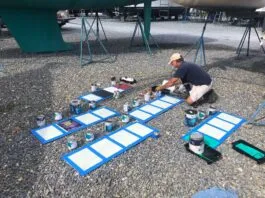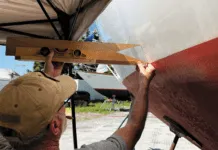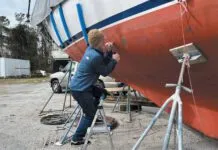Painting a New Bootstripe Like a Pro
Have you been wanting to add a bootstripe to your boat but aren’t sure how to do it? Perhaps you have a bootstripe already...
The Scraper-only Approach to Bottom Paint Removal
Spring is just around the corner. For many sailors, especially those with boats on the hard, it’s good time to consider the advantages of...
Real World Antifouling Testing
In addition to our panel testing of dozens of paints, we applied six different antifouling paints to our test boat, a Corsair F-24 trimaran....
Antifouling for Brackish Water
For two years, we’ve been soaking both our test boat and 11 test panels with 30 different antifouling paints in Rockhold Creek, a brackish...
Bottom Paints for Brackish Water at 1 Year
For more than four decades, Practical Sailor has been testing bottom paints, although for the first few years, the topic really didn’t draw much...
Bottom Paint Removal Decision Time
However you choose to use your scarce time, we’ll wager that you’d rather not spend it removing bottom paint. If you are an owner of an older boat with a decade of accumulated hard bottom paint that is flaking and cracking, now is a good time to start weighing your options for removing the old paint. Should you do it yourself, or hire the professionals—or a bit of both? Our experts break down the different approaches to removing old antifouling and the compare the estimated costs of each.
Bottom Paints for Brackish Water
Prior PS bottom paint testing focused on saltwater locations in Florida and Massachusetts. This time we’ve moved our testing racks to the brackish waters...
Exterior Wood Finish Update at 2 Years
Boxed and stored as PS went through three office moves in a short time frame, the wood samples we varnished in late 2015 finally...
Even 2020 Yielded Some Great Gear
Once more, the bulk of the past year’s testing focused on maintenance products, safety essentials, and do-it-yourself substitutes for higher priced marine gear. Part...
Four Solvents for Nearly Every Boat Job
As with cleaners (see One Bucket Cleaning Kit, May 2017) its easy to be over-specific with solvents. Pretty soon, we end up with a zillion cans in the paint locker. While we would probably pay extra for the magic vendor-specific blend for a topside paint job, wed not be so selective for every single small varnish, fiberglass, or similar job that comes up. For these everyday jobs, a few generics can do the trick.


















































